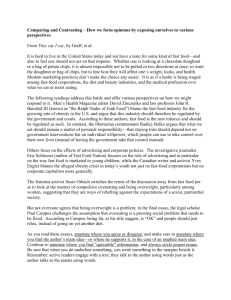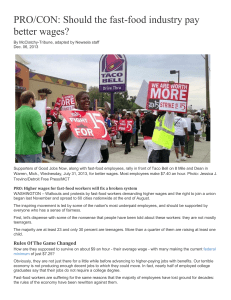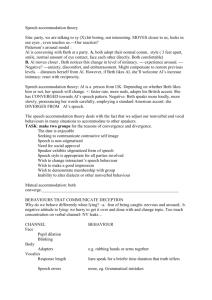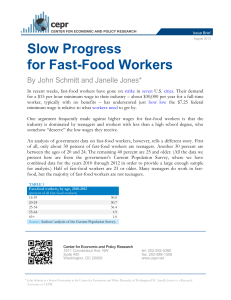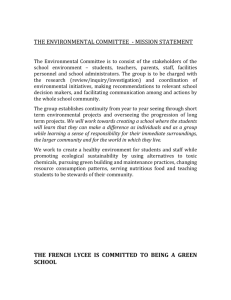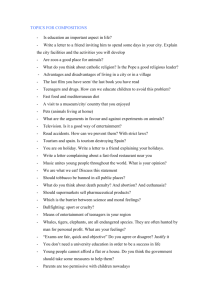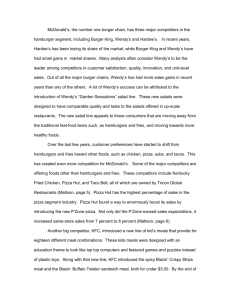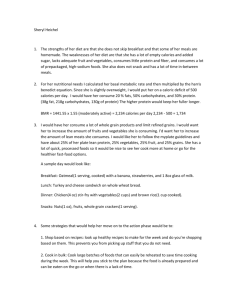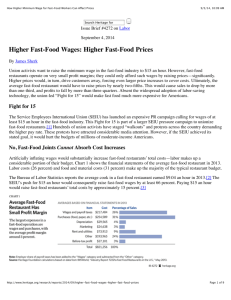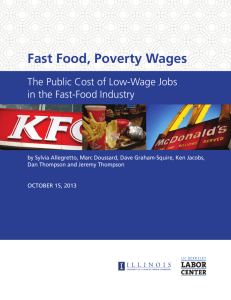Super-Sizing Public Costs - National Employment Law Project
advertisement
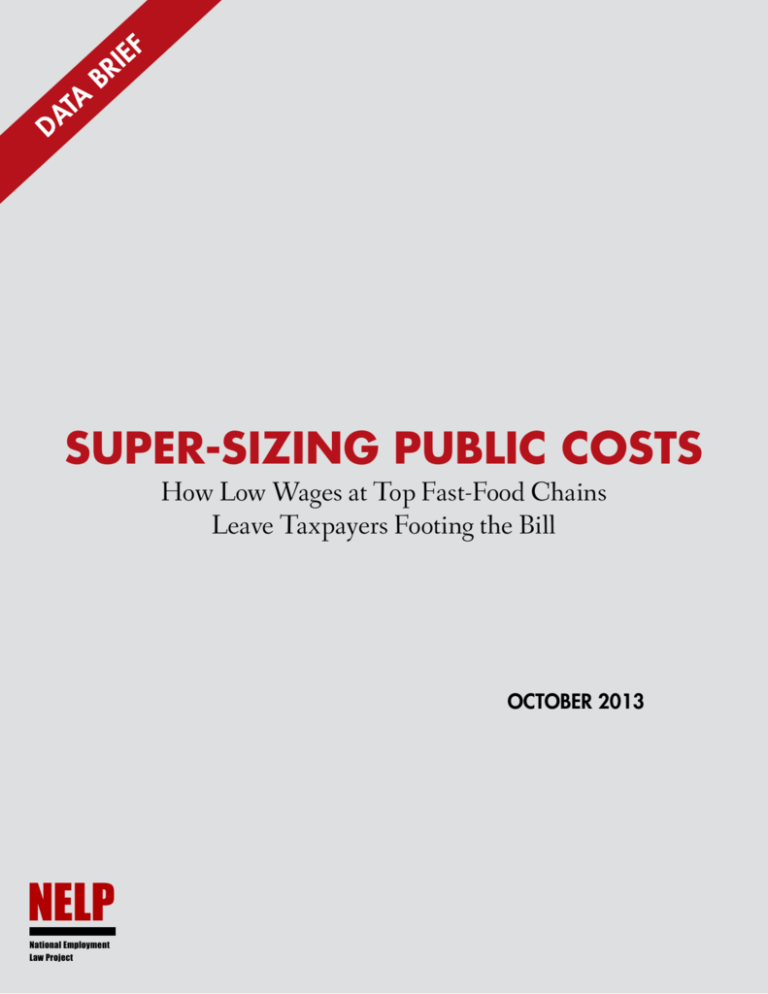
A T DA B E RI F Super-sizing public Costs How Low Wages at Top Fast-Food Chains Leave Taxpayers Footing the Bill OCTOBER 2013 NELP National Employment Law Project National Employment Law Project | 1 T he fast-food industry is marked by two extremes. On the one hand, the leading companies in the industry earn billions in profits each year, award chief executives generous compensation packages, and regularly distribute substantial amounts of money in the form of dividends and share buybacks. At the same time, the overwhelming share of jobs in the fast-food industry pay low wages that force millions of workers to rely on public assistance in order to afford health care, food, and other basic necessities. This report focuses on the 10 largest fast-food companies in the United States and estimates the substantial costs that these highly profitable companies’ low-wage, no-benefits business model imposes on taxpayers. Our findings include the following: • Low wages and lack of benefits at the 10 largest fast-food companies in the United States cost taxpayers an estimated $3.8 billion per year. McDonald’s alone costs taxpayers an estimated $1.2 billion each year. • While low wages and lack of benefits cost taxpayers billions of dollars each year, the seven publicly-traded corporations on this list remain in strong financial condition today. Last year, these companies collectively: • Earned $7.44 billion in profits; • Paid $52.7 million to their highest-paid executives; • Distributed $7.7 billion in dividends and buybacks. Figure 1. 10 Largest Fast-Food Companies by Size of U.S.-Based Restaurant Workforce Company Estimated Total U.S. Restaurant Workforce1 Total U.S. Restaurants2 Estimated Average Employees Per U.S. Restaurant3 1. McDonald’s 707,850 14,157 50 2. Yum! Brands (Pizza Hut, Taco Bell, and KFC) 379,449 18,069 21 3. Subway 255,490 25,549 10 4. Burger King 208,307 7,183 29 5. Wendy’s 162,876 5,817 28 6. Dunkin’ Donuts 160,732 7,306 22 7. Dairy Queen 133,860 4,462 30 8. Little Caesars 73,460 3,673 20 9. Sonic 96,012 3,556 27 10. Domino’s 73,920 4,928 15 Total 2,251,956 Source: See endnotes 1-3 1 | Super-Sizing Public Costs The Cost of Low Wages at the 10 Largest Fast-Food Companies According to a study by researchers at the University of California-Berkeley, more than half (52 percent) of front-line fast-food workers must rely on at least one public assistance program to support their families. 4 As a result, the fast-food-industry business model of low wages, non-existent benefits, and limited work hours costs taxpayers an average of nearly $7 billion every year. While payroll data for individual fast-food companies is not publicly available, we estimate that the low-wage business model at the 10 largest fast-food companies in the United States costs taxpayers more than $3.8 billion each year. As the largest employer in the fastfood industry, McDonald’s alone costs taxpayers nearly twice as much as its next-largest competitor, Yum! Brands. Figure 2. Estimated Annual Cost of Public Assistance to Employees at 10 Largest Fast-Food Companies Company Estimated Average Annual Cost of Public Assistance Provided to Employees5 McDonald's $1.2 billion Yum! Brands (Pizza Hut, Taco Bell, and KFC) $648 million Subway $436 million Burger King $356 million Wendy's $278 million Dunkin' Donuts $274 million Dairy Queen $228 million Little Caesars $125 million Sonic $164 million Domino's $126 million TOTAL $3.8 billion Source: See endnotes 4. Figures may not sum to total due to rounding. National Employment Law Project | 2 Largest Fast-Food Companies Are in Strong Financial Condition While paying low wages to millions of their front-line workers, the largest fast-food companies in the United States have paid their top executives multi-milliondollar compensation packages and have distributed substantial sums each year in dividends and stock buybacks. Taken together, the scale of the executive compensation packages, annual profits, dividends, and stock buybacks illustrate the strong financial position of the largest fast-food companies. Figure 3. Financial Condition of the Largest Fast-Food Companies in the U.S. (FY 2012) 6 Company CEO Total CEO Compensation Profits Dividends and Stock Buybacks McDonald's Donald Thompson $13.7 million $5.46 billion $5.5 billion Burger King Yum! Brands (Pizza Hut, Taco Bell, KFC) Bernardo Hees 7 $6.4 million $117.7 million $14 million David Novak $14.1 million $1.59 billion $1.5 billion Wendy’s Emil Brolick $5.8 million $7.08 million $39 million Dunkin’ Donuts Nigel Travis $1.9 million $108.3 million $520 million Sonic J. Clifford Hudson $1.7 million $30 million Domino’s J. Patrick Doyle $9.1 million $36.08 million $112.39 million $52.7 million $7.44 billion $7.7 billion Company TOTAL $88 million Source: NELP analysis of data from Standard & Poor’s Capital IQ. Figures may not sum to total due to rounding. 3 | Super-Sizing Public Costs 1. Estimated total U.S. restaurant workforce for each company is calculated by multiplying the estimated average employees per restaurant by the total U.S. restaurant locations for each company. Estimated total U.S. restaurant workforce refers only to restaurant employees, and excludes corporate staff, supply chain employees, and other non-restaurant workers. 2. Total U.S. restaurants include corporate-owned and franchised locations. Figures provided by Nation’s Restaurant News 2013 Top 100 report. 3. Average number of employees per restaurant is estimated based on public statements by company representatives, as well as analyses of data contained in public filings for each company. 4. Allegretto, et. al, “Fast Food, Poverty Wages: The Public Cost of Low-Wage Jobs in the Fast-Food Industry,” University of California-Berkeley, October 2013. 5. Total public cost for each company is estimated by multiplying (1) the average public cost per employee in the fast-food industry by (2) the total number of “core” front-line workers at each company: (1) According to Allegretto, et al. (2013), the average public cost per employee (including family members of the employee) in the fast-food industry equals $3,837.68 per year. This figure refers to the public cost of participation among fast-food workers (and members of their families) in five public safety net programs: Medicaid, State Children’s Health Insurance, the federal Earned Income Tax Credit, the Supplemental Nutrition Assistance Program, and Temporary Assistance for Needy Families. (2) “Core” front-line employees at each company refers to front-line workers who are employed for at least 27 weeks per year and at least 10 hours per week in a given year, as defined in Allegretto, et al. (2013). The “core” front-line fast-food workforce represents approximately 44 percent of the entire industry workforce. 6. Due to lack of publicly-available financial data, Figure 3 excludes the privately-held firms Subway, Dairy Queen, and Little Caesar’s. 7. Effective June 7, 2013, Daniel S. Schwartz replaced Bernardo Hees as CEO of Burger King. Total compensation cited in Figure 3 refers to Bernardo Hees, as published in most recent Burger King 10-K (February 22, 2013). NELP National Employment Law Project The National Employment Law Project is a non-partisan, not-for-profit organization that conducts research and advocates on issues affecting low-wage and unemployed workers. In partnership with grassroots and national allies, NELP promotes policies to create good jobs, enforce hard-won workplace rights, and help unemployed workers regain their economic footing. For more about NELP, please visit www.nelp.org National Employment Law Project | 4
